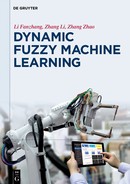Other forms are similar to prove.
[Prove up].
Other forms are similar to prove.
[Prove up].
8.2Dynamic fuzzy relations
8.2.1The conception dynamic fuzzy relations
In the real word, there are a large number of relations that are dynamic and fuzzy. In some way, it reflects whether the relationship is close or apart and whether the relations are dynamic. “Wang Fang grows more and more like her mother” and “The relationship between the students and teachers is more and more harmonious” – these are dynamic fuzzy relations.
Definition 8.6 Assume (X↼,X⇀) is a common DFD set and (L↼,L⇀) is dynamic fuzzy lattice; we call the mapping (A↼,A⇀): (X↼,X⇀)→(L↼,L⇀)as(L↼,L⇀) type dynamic fuzzy set, and we note that DF(L↼,L⇀)(X↼,X⇀)={(A↼,A⇀):(X↼,X⇀)→(L↼,L⇀)}.
Assume (A↼,A⇀),(A↼,B⇀)∈DF(L↼,L⇀)(X↼,X⇀),if(A↼,A⇀)(x↼,x⇀)≤(B↼,B⇀)(x↼,x⇀),(∀(x↼,x⇀)∈(X↼,X⇀)). Namely, contained in (B↼,B⇀), we note that (A↼,A⇀)⊂(B↼,B⇀), then(DF(L↼,L⇀)(X↼,X⇀),c) is dynamic fuzzy poset.
Definition 8.7 If (R↼,R⇀)∈DF((X↼,X⇀)×(Y↼,Y⇀)), we note that (R↼,R⇀) is the L-type dynamic fuzzy relations among (X↼,X⇀) to (Y↼,Y⇀); if (L↼,L⇀)=[(0↼,0⇀),(1↼,1⇀)],(R↼,R⇀)∈DF((X↼,X⇀)×(Y↼,Y⇀)), then we note that (R↼,R⇀) is the dynamic fuzzy relations among (X↼,X⇀)to(Y↼,Y⇀).
Definition 8.8 As mentioned, binary dynamic fuzzy relations can be promoted to n set dynamic fuzzy relations.
Definition 8.9 Assume (X↼1,X⇀1),(X↼2,X⇀2),...,(X↼n,X⇀n) is n nonempty set, then
(R←,R→):(X←1,X→1)×(X←2X→2)×...×(X←n,X→n)→[(0←,0→),(1←,1→)].
We note that (X↼,X⇀)=X↼1,X⇀1)×(X↼2,X⇀2)×...×(X↼n,X⇀n) as the n set dynamic fuzzy relations.
8.2.2Property of dynamic fuzzy relations
Proposition 8.1 Assume (R↼,R⇀),(S↼,S⇀),(P↼,P⇀),(R↼,R⇀)(t↼,t⇀)∈DF((X↼,X⇀)×(Y↼,y⇀)),(t↼,t⇀)∈(T↼,T⇀), then we have the following properties:

(6)(R←,R→)∨(I←,I→)=(I←,I→),(R←,R→)Λ(I←,I→)=(R←,R→) (R←,R→)∨(0→,0←)=(R←,R→),(R←,R→)Λ(0→,0←)=(0←,0→),
where (I↼,I⇀),(O↼,O⇀)∈DF((X↼,X⇀)×(Y↼,Y⇀)), (I↼,I⇀)((x↼,x⇀),(y↼,y⇀))=(1↼,1⇀),(0↼,0⇀)((x↼,x⇀),(y↼,y⇀))=(0↼,0⇀) (∀(x↼,x⇀),(y↼,y⇀))∈((X↼,X⇀),(Y↼,Y⇀))). We note respectively that dynamic fuzzy universal relation and dynamic fuzzy zero relation among (X↼,X⇀) to (Y↼,Y⇀).
Definition 8.10 If (R↼1,R⇀1),(R↼2,R⇀2)∈DF(L↼,L⇀)((X↼,X⇀),(Y↼,Y⇀))∀((x↼,x⇀),(y↼,y⇀))∈((X↼,X⇀),(Y↼,Y⇀)), we define that:

Theorem 8.9 (R↼,R⇀)−1 have the following properties:
1) (R←1,R→1)⊂(R←2,R→2)⇒(R←1,R→1)−1⊂(R←2,R→2)−12) ((R←,R→)−1)−1=(R←,R→)3) ((R←1,R→1)∪(R←2,R→2))−1=(R←1,R→1)−1∪(R←2,R→2)−14) ((R←1,R→1)∩(R←2,R→2))−1=(R←1,R→1)−1∩(R←2,R→2)−1
8.2.3Dynamic fuzzy matrix
Definition 8.11 We name the matrix like
Unexpected text node: ' e ' as DF matrix with m × n order, where Unexpected text node: ' e ' we name Unexpected text node: ' e ' as the elements in row i and column j of DF matrix (E↼,E⇀).
Assume (X↼,X⇀)={(x↼1,x⇀1),(x↼2,,x⇀2),...,(x↼n,x⇀n)}, (Y↼,Y⇀)={(y↼1,y⇀1),(y↼2,y⇀2)...,(y↼m,y⇀m)}, ((L↼,L⇀),≤) is DF lattice, (0↼,0⇀),(1↼,1⇀) are the maximum an minimum element in (L↼,L⇀).
Definition 8.12 If (R↼,R⇀): (X↼,X⇀)×(Y↼,Y⇀)→(L↼,L⇀), we name that (R↼,R⇀) is (L↼,L⇀)-type DF matrix; we note that


